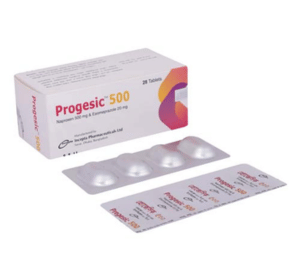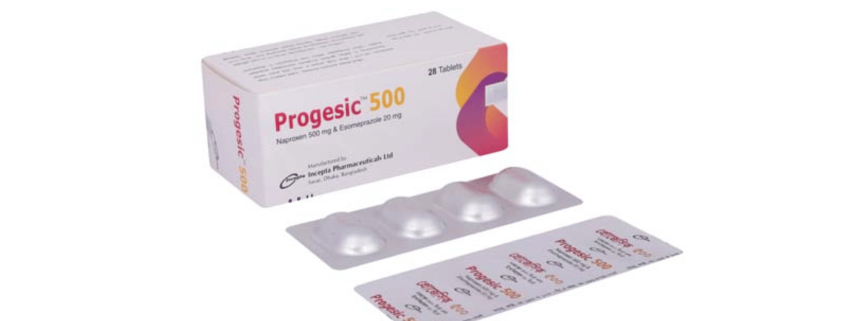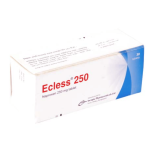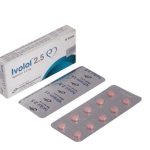Progesic(Naproxen & Esomeprazole)

Therapeutic Group: Analgesic, Anti Inflammatory
Presentation
Progesic 375 Tablet: Each tablet contains delayed release Naproxen BP 375 mg and immediate release Esomeprazole Magnesium Trihydrate BP equivalent to Esomeprazole 20 mg.
Progesic 500 Tablet: Each tablet contains delayed release Naproxen BP 500 mg and immediate release Esomeprazole Magnesium Trihydrate BP equivalent to Esomeprazole 20 mg.
Description
Progesic consists of an immediate release Esomeprazole magnesium layer and an enteric coated Naproxen core. As a result Esomeprazole is released first into the stomach, prior to the dissolution of Naproxen in the small intestine.
Naproxen is a NSAID with analgesic and antipyretic properties. The mechanism of action of Naproxen is to inhibition of the prostaglandin synthesis. Esomeprazole is a proton pump inhibitor that suppresses gastric acid secretion by specific inhibition of the H+/K+-ATPase in the gastric parietal cell. By acting specifically on the proton pump, Esomeprazole blocks the final step in acid production, thus reducing gastric acidity
Indications
It is indicated for the relief of signs and symptoms of osteoarthritis, rehumatoid arthritis and ankylosing spondylitis, dysmenorrhoea and to decrease the risk of developing gastric ulcers in patients at risk of developing NSAID associated gastric ulcers.
Dosage & Administration
Carefully consider the potential benefits and risks of Progesic and other treatment options before deciding to use Progesic. Use the lowest effective dose for the shortest duration consistent with individual patient treatment goals. If a dose of Esomeprazole lower than a total daily dose of 40 mg is more appropriate, a different treatment should be considered.
Rheumatoid Arthritis, Osteoarthritis, Alkylosing Spondylitis, and dysmenorrhoea: Progesic 375 or 500 one tablet twice daily as directed by the physician.
• Do not split, chew, crush, or dissolve the tablet. Progesic is to be taken at least 30 minutes before meals.
Elderly patients
Studies indicate that although total plasma concentration of naproxen is unchanged, the unbound plasma fraction of naproxen is increased in the elderly. Use caution when high doses are required and some adjustment of dosage may be required in elderly patients. As with other drugs used in the elderly use the lowest effective dose.
Patients With Moderate to Severe Renal Impairment
Naproxen-containing products are not recommended for use in patients with moderate to severe or severe renal impairment (creatinine clearance <30 mL/min).
Hepatic Insufficiency
Monitor patients with mild to moderate hepatic impairment closely and consider a possible dose reduction based on the naproxen component of Progesic. Progesic is not recommended in patients with severe hepatic impairment because esomeprazole dosage should not exceed 20 mg daily in these patients.
Children
Dosage in children less than 18 years has not been established.
Side Effects
In general, Progesic is well tolerated. The most common adverse reactions in clinical trials (>5%): erosive gastritis, dyspepsia, gastritis, diarrhea, gastric ulcer, upper abdominal pain, nausea etc.
Contraindications
• Known hypersensitivity to any component of Progesic or substituted benzimidazoles
• History of asthma, urticaria, or other allergic-type reactions after taking aspirin or other NSAIDs
• Use during the peri-operative period in the setting of coronary artery bypass graft (CABG) surgery
• Late pregnancy
Precautions
Patients with known CV disease/risk factors may be at greater risk. Progesic should be used with caution in patients with fluid retention or heart failure.
Use in Pregnancy & Lactation
In pregnancy: Pregnancy category C. In late pregnancy, it should be avoided because it may cause premature closure of the ductus arteriosus.
In lactation: Progesic should not be used in nursing mothers due to the naproxen component.
Drug Interaction
• Concomitant use of NSAIDs may reduce the antihypertensive effect of ACE Inhibitors, diuretics, and beta-blockers
• Concomitant use of Progesic and warfarin may result in increased risk of bleeding complications.
• Esomeprazole inhibits gastric acid secretion and may interfere with the absorption of drugs where gastric pH is an important determinant of bioavailability (eg, ketoconazole, iron salts and digoxin).
Over Dose
There is no clinical data on overdosage with Progesic.
Overdose of Naproxen: Significant naproxen overdosage may be characterized by lethargy, drowsiness, epigastric pain, abdominal discomfort, heartburn, indigestion, nausea, transient alterations in liver function, hypoprothrombinemia, renal dysfunction, metabolic acidosis, apnea, vomiting etc.
Overdose of Esomeprazole: The major signs of acute toxicity were reduced motor activity, changes in respiratory frequency, tremor and intermittent clonic convulsions etc
Commercial Pack
Progesic 375 Tablet: Each box contains 3 Alu-Alu blister strips of 10 tablets.
Progesic 500 Tablet: Each box contains 7 Alu-Alu blister strips of 4 tablets.



